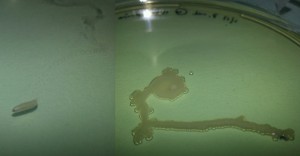 Entering into a prominent research university, I knew that I had to unfold the meaning of real research in practical terms. As a freshman, I quickly found Rutgers to be a fertile ground of high-caliber biology faculty who simultaneously make advances in their respective fields and take great pains to involve undergraduates in their labs. Here, important questions are raised; new interdisciplinary approaches are pursued; and ideas for future research are renewed.
Entering into a prominent research university, I knew that I had to unfold the meaning of real research in practical terms. As a freshman, I quickly found Rutgers to be a fertile ground of high-caliber biology faculty who simultaneously make advances in their respective fields and take great pains to involve undergraduates in their labs. Here, important questions are raised; new interdisciplinary approaches are pursued; and ideas for future research are renewed.
Over the past year, I have focused on developing a potential direction where human organ transplants could be conducted within a greater window of time. The shelf lives of organs are relatively short with the heart as little as six hours before it loses its viability. In the Yakoby Lab, along with fellow undergraduates, I aim to find a mechanism that heightens their tolerance to lower temperatures. Fortunately, a mechanism has already been found in ice worms, which naturally live on glacier ice. The Shain Lab, also at Rutgers, observed a particular characteristic of these ice worms; they display high levels of energy, which is believed to enhance their survivability on ice. Upon recapitulating this mechanism in E. coli, they found that these mutant bacterial cells were significantly more cold tolerant than wild-type cells. An exciting find, indeed!
 Drawing primarily from this research, we endeavor to evaluate this mechanism in fruit flies. Because fruit flies have similar cellular mechanisms as that of humans, they are a powerful system for cold tolerance tests. To evaluate for cold tolerance in these flies, we developed a mobility test of third-instar larvae under different temperatures. Our results indicate that significant differences in mobility across species are present between certain specified temperature intervals. Our findings of cold tolerance provide tools to continue studying the effects of lower temperatures on the wild type and flies with elevated energy levels. We hope that our research would ultimately contribute to the research on extending the rigid shelf life of donated human organs.
Drawing primarily from this research, we endeavor to evaluate this mechanism in fruit flies. Because fruit flies have similar cellular mechanisms as that of humans, they are a powerful system for cold tolerance tests. To evaluate for cold tolerance in these flies, we developed a mobility test of third-instar larvae under different temperatures. Our results indicate that significant differences in mobility across species are present between certain specified temperature intervals. Our findings of cold tolerance provide tools to continue studying the effects of lower temperatures on the wild type and flies with elevated energy levels. We hope that our research would ultimately contribute to the research on extending the rigid shelf life of donated human organs.
